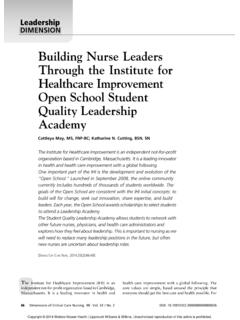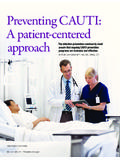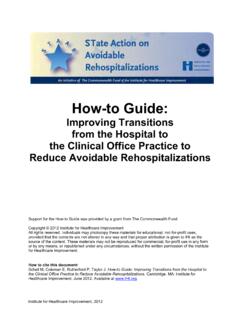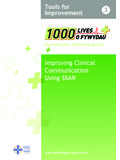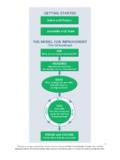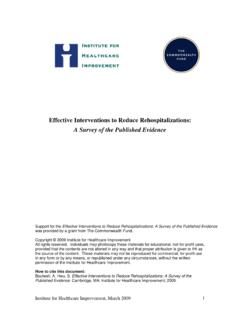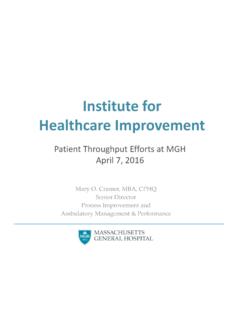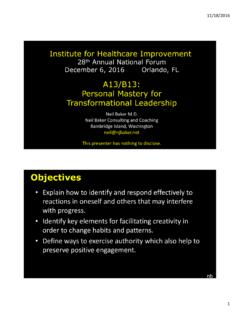Transcription of Innovation Series 2006 Leadership Guide to Patient Safety
1 Leadership Guideto Patient Safety12 Innovation Series 2006 Copyright 2006 institute for healthcare ImprovementAll rights reserved. Individuals may photocopy all or parts of white papers for educational, not-for-profit uses. These papers may not be reproduced for commercial, for-profit use in any form, by anymeans (electronic, mechanical, xerographic, or other) or held in any information storage or retrievalsystem without the written permission of the institute for healthcare to cite this paper:Botwinick L, Bisognano M, Haraden C.
2 Leadership Guide to Patient Safety . IHI Innovation Series white paper. Cambridge, Massachusetts: institute for healthcare improvement ; 2006 . (Available on )Acknowledgements:The institute for healthcare improvement (IHI) would like to thank the following individuals for their contributions to the work:Donald M. Berwick, MD, MPP, FRCP, President and CEO, IHID onald Goldmann, MD, Senior Vice President, IHIF rances A. Griffin, RRT, MPA, Director, IHIJ ulianne Morath, RN, MS, Chief Operating, Children s Hospitals and Clinics of MinnesotaGail A.
3 Nielsen, BSHCA, Clinical Performance improvement Education Administrator, Iowa Health System, and IHI George W. Merck Fellow 2004 2005 Thomas Nolan, PhD, Statistician, Associates in Process improvement , and IHI Senior FellowJames L. Reinertsen, MD, President, The Reinertsen Group, and IHI Senior FellowRoger K. Resar, MD, Assistant Professor of Medicine at the Mayo Clinic School of Medicine and Change Agent for Luther Midelfort and Mayo Foundation; IHI Senior FellowWilliam C. Rupp, MD, President and CEO, Immanuel St.
4 Joseph s Mayo Health SystemJohn Whittington, MD, Patient Safety Officer and Medical Director of Knowledge Management, OSF healthcare SystemIHI also thanks staff members Jane Roessner, PhD, and Val Weber for their editorial review and assistance with this reprints requests, please contact: institute for healthcare improvement , 20 University Road, 7th Floor, Cambridge, MA 02138Te l e p h o n e ( 6 1 7 ) 3 0 1 - 4 8 0 0 , o r v i s i t o u r w e b s i t e a t w w w. i h i . o r gWe h a ve d e ve l o p e d I H I s In n ova t i o n Se r i e s w h i t e p a p e r s t o f u r t h e r o u r m i s s i o n o f i m p rov i n g t h equality and value of health care.
5 The ideas and findings in these white papers represent innovativework by organizations affiliated with IHI. Our white papers are designed to share with readers theproblems IHI is working to address; the ideas, changes, and methods we are developing and testingto help organizations make breakthrough improvements; and early results where they exist. Leadership Guideto Patient SafetyInnovation Series 2006 Authors:Laura Botwinick:Vice President, Joint Commission Resources and Co-Director, Joint CommissionInternational Center for Patient Safety ; IHI George W.
6 Merck Fellow 2004 2005 Maureen Bisognano:Executive Vice President and Chief Operating Officer, IHIC arol Haraden, PhD:Vice President, IHII nnovation Series : Leadership Guide to Patient Safety1 I know you didn t mean to hurt me. Elizabeth, eight years old, paralyzed from the waist down after a recurrence of cancer was missed(excerpted from R. Gibson, Wall of Silence ) Our systems are too complex to expect merely extraordinary people to perform perfectly 100 percentof the time. We as leaders have a responsibility to put in place systems to support safe practice.
7 James Conway, IHI Senior Fellow; former Executive Vice President and Chief Operating Officer,Dana-Farber Cancer InstituteIntroductionThe numbers are now widely known: 44,000 to 98,000 Americans die each year as a result of medical errors. Since these staggering figures were published by the institute of Medicine (IOM) inthe 1999 report, To E r r I s H u m a n ,1much pioneering and innovative work has been done to reduceadverse medical events and eliminate the harm they cause. This paper shares the experience of seniorleaders who have decided to address Patient Safety and quality as a strategic imperative within theirorganizations.
8 It presents what can be done to make the dramatic changes that are necessary toensure that patients are not harmed by the very care systems they trust will heal them. The Unique Role of Boards and Senior Leaders in Patient Safety Leadership is the critical element in a successful Patient Safety program and is non-delegable. Onlysenior leaders can productively direct efforts in their health care organizations to foster the cultureand commitment required to address the underlying systems causes of medical errors and harm topatients.
9 For the purposes of this paper, senior leaders are defined as CEOs and the executives whoreport to them, senior clinical leaders, and Board members. The unique role of Leadership is toestablish the value system in the organization; set strategic goals for activities to be undertaken; alignefforts within the organization to achieve those goals; provide resources for the creation, spread, and sustainability of effective systems; remove obstacles to improvements for clinicians and staff; and require adherence to known practices that will promote Patient Safety .
10 When leaders begin tochange their responses to mistakes and failure, asking what happenedinstead of who made the error,the culture within their health care institutions will begin to Personal Connection to the IssueAlthough it is now widely accepted that serious medical errors and harm occur in health care organizations, many leaders hold the view that it couldn t happen here. Organization leaders are encouraged to seek out the stories about harm to patients that has occurred in their own institutions, understand how the harm occurred, and use the stories to drive improvement .



